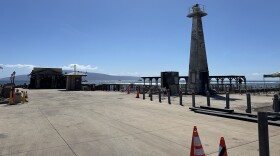Sea turtle nesting season has begun across the Hawaiian Islands, as adult female sea turtles return to shore each summer in search of an ideal spot to lay their eggs.
Honu nests may take around 60 days to hatch, making the weeks leading up to incubation especially important. During this time, beachgoers can expect to see protective signage and stakes around honu nests to help safeguard hatchlings from harm.
Five different types of sea turtle species inhabit Hawaiian waters; however, the green sea turtle (honu) and hawksbill (honuʻea) are the most commonly encountered species in Hawai’i.

Some sea turtle species are threatened, while others are endangered, though in Hawaiʻi, all are protected by the Endangered Species Act and additionally protected by state law.
Kristen Kelly serves as the marine species outreach and education coordinator for the Department of Land and Natural Resources, where she plays a key role in protecting sea turtles through education and enforcement of conservation laws.
“On Oʻahu, it's actually illegal to drive on the beach, unless it's in a permitted area,” Kelly said. “Campfires also are technically illegal on most beaches in Hawaiʻi. That is something that should be illegal year-round, but it is not highly enforced.”
“So it's harder for people to change what they've been used to for years when these sea turtle nests come out. There are no laws around having your lights bright on the beach, and that's where the Endangered Species Act comes in.”

The DLNR advises the public to support sea turtles throughout peak nesting season from August through November by offering at least 10 feet of space, avoiding handling hatchlings, and not driving on beaches. Beach-facing lights from vehicles and homes should be turned off during nesting and hatchling season.
If you must be on the beach after dark, use only red-filtered flashlights. Additionally, campfires are illegal on Hawaiʻi’s beaches and are especially dangerous during nesting season.
Lights from vehicles or other sources can disorient hatchlings after they emerge, interfering with their natural instinct to follow the brightness of the moon and stars toward the ocean. Any minor disruption can significantly impact their chances of survival.
Kelly added that addressing the lighting issue is challenging and that change may be difficult, but noted that increased enforcement measures could be introduced in the coming years to help improve the situation.
“There are solutions, there's lights people could put up at their house and the hatchling wouldn't crawl to it or at our public bathrooms that stay open late,” Kelly said. “That was an issue of the last couple years at Sandy's Beach, the hatchlings crawled towards the bathroom. So there's going to be a lot of changes. But I think, education early for kids, so they appreciate the nest and don't want to continue activities of campfires and driving is important.”

Mālama i nā honu, which means to care for the turtles, is a volunteer-based nonprofit organization that assists with hatchling response on Oʻahu and Kauaʻi. Under a permit with the U.S. Fish and Wildlife Service, they work together to protect sea turtles during the nesting period.
Debbie Herrera is the volunteer education coordinator and nesting coordinator for Mālama i nā honu. Between Oʻahu, Kauaʻi and their expanding nesting program, Herrera said that the organization has about 275 to 300 volunteers.
“The organization itself manages about 50 beaches here on Oʻahu and 14 to 20 on Kauaʻi and that means we have volunteers walking every day because we have hotspots that we know there's going to be nesting,” Herrera said.
“We’re so blessed to have people who are willing to give so much time. Nesting is time-consuming. Laniākea might be six to 12 hours a month that they give, but nesting is every week for six to eight months during the nesting season, so it's a lot of hours these people are giving.”
Herrera explained that the program is based on coexistence and through its three pillars, education, public awareness and conservation, the organization has developed basking data from sea turtles that emerge from the ocean to lie in the sand and soak up the sun.

“Every sea turtle has very specific facial patterns, which to you and I would be like our fingerprint, so we have trained our volunteers to watch these animals,” Herrera said. “We know that turtles are going to come, we know that tourists and visitors are going to come and we know that local residents are going to come, so how do we coexist together? It's to have information that we can share with all of these people about the coexistence and how that looks.”
Mālama i nā honu is able to track trends and gain more knowledge from the honu by comparing the sea turtles with the years of data collected on specific turtles at Laniākea and Poʻipū Beach.
Herrera said that through education work with keiki, she has seen conservation make an impact.
“I really am a firm believer that if you can get the young keiki to embrace the wildlife from an early age, they start to remember that, ‘Oh, we’re not supposed to get by that turtle,’” Herrera said. “I do see these moments where the education, even though these are young keiki, it's still turned to all of their family. Kids, no matter what age, really do have a sense of responsibility that you're not putting on them but they are taking on themselves.”
Report injured, dead or hatching turtles to the NOAA Marine Wildlife Hotline: 888-256-9840. Report violations of beach driving to DLNR Enforcement: 808-643-3567. To find out about volunteer opportunities with Mālama i nā honu, click here.




